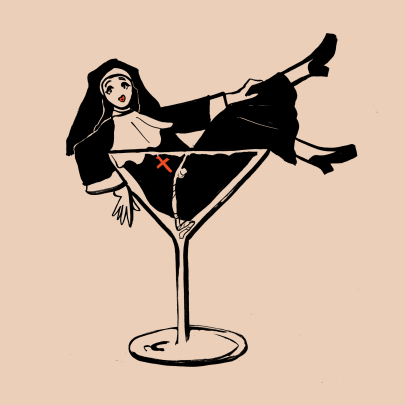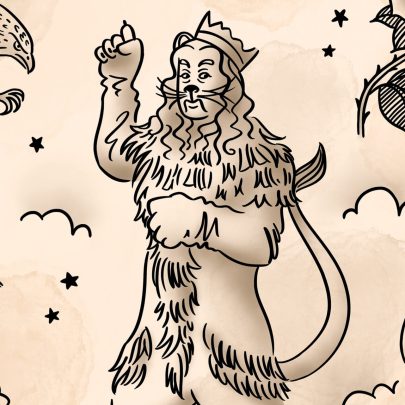Feb 16, 2015 Theatre
James Wenley’s Auckland Fringe week one in review.
Above: Sam Brooks in Stutterpop, photographed by Duncan Innes.
5. Hot Dogs and Bananas
Is dressing up as non-relevant, vaguely-phallic food items the trend for this Fringe? Frank the Mind-Reading Hotdog is a mind-reader who also happens to be dressed as a hotdog. Wellington’s Binge Culture collective staged their six hour performance event, Break-Up (We Need to Talk) dressed in bright yellow banana skins. Frank is more than just a hotdog suit and I implored Aucklanders to see his show last week. I hope you did! In Break Up, the bananas lend just the right absurdity to prevent the show from becoming too much of an endurance for those watching. Improvised by a company of four, they take turns being the one in the “hot seat” as they go over the detritus of their relationship. And over. And over. Though the seating arrangement cancels out intimacy (like the hour in the break-up where you just madly hold each other tight), the acrimonies, reversals of position, and the impossibility of arriving on the same page feels real and honest. But if things are getting too heavy, all you have to do is remind yourself you are watching four bananas, and it’s a little more bearable.
4. Tom Cruise Cameos
Phoebe Borwick and Susannah Smith-Roy’s Suri vs. Shiloh is set in 2024 and imagines Suri Cruise and Shiloh Jolie-Pitt as teen tearaways tired of fan and media attention. It’s as shallow as its depiction of the celebrity culture it seeks to satirise, but it does result in a lot of giggles. The best is whenever Tom Cruise himself, who appears to have stopped aging somewhere around the first Mission Impossible movie, pops up on screen. The lip synching by Smith-Roy is a riot, as is his terrible advice to his daughter.
3. Imma Let You Finish
Sometimes Fringe schedules can be a bitch, as Sam Brooks (pictured above) found. Stutterpop is written by Brooks to be 45 minutes, but as performed by Brooks, it can stretch out indefinitely. Brooks has two personal stories to tell: tales from his inglorious love life, and his day to day experience of having a stutter. For followers of Brooks work his failures in love and exploration of sexuality are not new, and here he admits to shamelessly mining his biography for plays including Riding in Cars with (Mostly) Straight Boys, and re-using the same material here. What is new is Brooks so bravely exposing the vulnerabilities he feels around his stutter in front of a rather large audience. Brooks links his stutter with humiliation, the moment in conversation with somebody new that he is caught out as being “not a fluent person”. In Stutterpop his stutter begins almost as soon as he starts speaking. His cheeks widen, his eyes blink, with emotion and struggle is etched on his face. While has his moments of lucidity, it is his involuntary dialogue of “um, um, yeah” that loops and dominates throughout the show.
The audience don’t mind. It becomes like a Samuel Beckett play, incoherent yet utterly meaningful. The stutter also means that the pay-offs in Brook’s writing are all the more earned. His stutter kicks in just at the right moment when he tells us he took to therapy with gusto, “like a virgin pretending….”, and we have to wait for quite some time to find out how that particular simile will end.
With Friday Snort beating at the door, the Fringiest moment comes when Brooks allows his back-up dancer, Louisa Hutchinson, to take over and finish his script. Brooks elegantly steps aside, smile beaming from his face, as he watches Louisa tell the rest of his story. Brooks looks every inch like a winner on Oscar night, graciously allowing a colleague to give the acceptance speech on their behalf.
Brooks gives a raw, uncompromising performance. Stutterpop empowers Brooks and his audience, allowing us to walk in his (platform) shoes. And as a bonus, he makes for a fierce lip-synched and has a blast channelling pop-stars like the Veronicas, Gwen Stefani and Katy Perry.
2. A Ponsonby Walking Tour with a Difference
A woman, seeing our group of head-phone wearers approaching up Franklin Road, snootily commented: “Is this a walking tour? Oh how cute”. While she may have endorsed the contemporary image of the street as ‘Ponsnobby’, I Wanna Be Na Nah Na Nah Nah takes us back to “old school Ponsonby” of the 1980s. As we’re encouraged to sing-along with the performers on the bus trip from The Basement to the famous suburb, Ponsonby used to be “freaking slum” which Otara had nothing on.
Created by writers David Fane, Tessa Mitchell, and director Stephen Bain, the show is performed in two halves with an interval in between. I’m in the group that hears Fane’s story first, a series of funny and touching anecdotes about growing up Samoan in the suburb. We hear all this on wireless headphones, making sure we stay near signal range of Bain as we are led through both back streets and the main strip of Ponsonby Road. Performers Italia Hunt and Troy Tu’ua are like Ponsonby fairies (no not that kind), beings from another time that have come back to life. They flit joyously exploring their streets. Their actions mostly have little to do with Fane’s narration, though at times there are intersections. We pause by the St John’s Methodist Church as Fane recalls his strict religious instruction and wonders “what the hell can thou do?”
Mitchell’s audio reminiscing is more directly related to what we see as we experience her story in the second half of the piece. As embodied by dancer Phoebe Heyhoe (with appearances from Mitchell herself), Mitchell’s story is about a young women in Ponsonby moving from flat to flat and job to job as she discovers her identity. When relating her experiences of working as a cleaner in a “horrible and scuzzy” brothel, Heyhoe hangs out white towels on a street railing.
The event encourages you to take another look at your surroundings. I appreciate the historic and new – from the white-washed wooden character homes of Renall Street that all look the same to newer apartments that everyone seems so worried about. Neighbourhoods change. In Fane’s story, he returns from drama school to find a neighbourhood changed through gentrification. He notices there are more fences, the routes open to him as a child now closed. I Wanna Be beautifully evokes the Ponsonby of yesteryear in all its slummy glory and makes it vivid again. For some audience members, the show was a trip into their own pasts and associations with Ponsonby the place. At the interval in a community hall, you can put post-it notes on a map of landmarks that are personally significant to you. I’m jealous of the person who wrote that they bought their first home in Ponsonby for 1977 for $17,000.
A walking trip? No, much more. The stories we hear on our headphones could easily play in a National Radio drama slot. But the walking experience the creators have developed to go alongside it helps fully transport you. Only a small number can do the show each time, and already the season is sold out. It’s supported by the Ponsonby Business Association and you are encouraged to stick around afterwards and go to the bars and restaurants. I encourage them to look at extending the season, so even more can experience what old and current Ponsonby has to offer.
1. Nic Sampson, Dressed as a Vagina, Being Pleasured by Two Audience Volunteers
Political pundits avert your eyes. Comedian Freya Desmarais was inspired to create Live Orgy based on a conversation she had with Green MP Catherine Delahunty a few years back where they discussed the state of sex education in New Zealand’s schools, and agreed that masturbation should be taught as part of this curriculum. Desmarais can tell you exactly what is wrong with what is taught in schools, and furthermore, she knows how to fix it.
At the top of the show she gleefully announces the risqué title was designed to entrap us for an evening of discourse about sexuality, rape culture, and feminism in 2015. Desmarais is remarkably upfront about her personal experiences. It’s not easy hearing about her realisation after the fact that she had not given consent to her first sexual partners. Freya thinks our way of talking about sex in this country needs to change. Taking the boot to New Zealand’s puritanism, Freya advocates for frank but positive discussion of sex in our culture and especially our schools.
Which brings us to the Fringiest moment of Week One. Now is a good time to mention that Desmarais is remarkably funny. As part of the Desmarais sexual instruction, she had been picking on the comedians in her audience to help make her points. She’d already called upon Eli Mathewson to help demonstrate how she was taught to walk in heels as part of her sex education class at school (yes, as part of sex education!), but on closing night Nic Sampson got the special honour of being dressed as a vagina (a red woollen bauble hat marking the sweet spot) while two other volunteers helped pleasure him with a makeshift foam penis and finger. Desmarais instructed the volunteers to “make the clitoris laugh”. Sampson responded, “Oh that’s what I’ve being doing wrong”. Taking a big gulp of drink, Sampson had to keep it together until he couldn’t hold it any more. You get the idea.
Live Orgy is the Fringe show that could revolutionise sexual education in New Zealand. I’m not joking. Can we take Live Orgy to the schools? It’s a big “Yes” from me.
Auckland Fringe runs to March 1. aucklandfringe.co.nz





